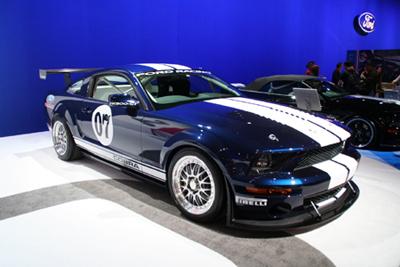Ford and Shelby reach new heights
 To earn a decent living while amateur racing in the 1940s, Carroll Shelby raised chickens. His first batch of broilers earned him $5,000, but the farm bug didn’t last. Shelby went bankrupt when his second group of chickens died.
To earn a decent living while amateur racing in the 1940s, Carroll Shelby raised chickens. His first batch of broilers earned him $5,000, but the farm bug didn’t last. Shelby went bankrupt when his second group of chickens died.“My chickens all had limberneck disease, and I was going broke,” says Shelby. “One day, I’d been vaccinating chickens and was running late. So I drove out to the racetrack in my overalls. It was about 110 degrees, and I decided to leave the overalls
on because I thought they would be cooler to drive in. I won the race, and everyone giggled and laughed, but they ran my picture in the paper in those overalls. I decided, shoot, this is a pretty good deal, and I just kept on doing it.”
Shelby continued to race — and win — and build an international reputation. In 1962, the planets aligned when AC Cars in England lost its supply of engines and, at the same time, Ford Motor Company had a new lightweight, small-block V-8 engine. Shelby’s idea was to marry the two; the result was the original 260/289 Cobra. In a small shop in southern California, Shelby eventually tweaked the formula to create the legendary 427 Cobra, and Ford and Shelby were, as they say, off and running.
“My energy and passion for performance products has always been strongest when it involved a vehicle from the Ford Motor Company,” says Shelby. “I couldn't be prouder than I am today to have the opportunity to re-create history with the only automotive company that holds the key to my heart.”
The epicenter of Shelby’s high-performance passion today is at the 2006 SEMA performance party in Las Vegas, where Shelby-badged Mustangs occupy center stage. The focal point is made up of three cars — one painted red, one white and one, you guessed it, blue. The red car is a GT500 dragster, an all-out drag racer ready to win any mod-motor class. The white Mustang is a GT500 Road and Track, a car that can be driven to work Monday through Friday and raced at the track on the weekend. The blue Shelby is an all-out competition GT500 race car. There are also a black 40th Anniversary Shelby GT500 convertible and a white Shelby GT coupe on display.
The street-legal drag car’s 5.4-liter V-8 features a Ford Racing supercharger that’s enhanced by a cold-air box from Paul’s High Performance (PHP) and by billet aluminum pulleys from Metco Motorsports. The engine also has modified reservoirs and oil pan, and the chassis has a tubular K-member from Anthony Jones Engineering. The transmission is a GT500 factory TR-6060 six-speed from TTC/Tremec with PHP shifter modifications. The stock front seats are swapped out for Recaro race buckets.
The Road and Track car is street-legal, modified with a Ford Racing Performance Parts power pack that boosts horsepower to approximately 600. There are also a Ford Racing handling pack (lower stance, larger antiroll bars, new strut tower brace and new dampers), performance friction brakes and three-piece Fikse race wheels.
The blue, track-only competition GT500 has a 5.0-liter Cammer engine that puts out more than 500 horsepower and is mated with a six-speed sequential shift race transmission. The brakes have six-piston front calipers with two-piece rotors; the rears have four-piston calipers with two-piece rotors. There are an 8.8-inch full floating rear axle, three-way adjustable dampers, a GT-spec rear wing, a carbon fiber nose splitter, a 22-gallon fuel cell and three-piece BBS racing wheels. Curb weight is a trim 3,100 pounds, about 800 pounds less than the conventional Shelby GT500.
“For Ford, this really is one of our Kodak moments,” says Bob Adams, a manager in Ford Motor Company’s Global Auto Show Strategy Department. “We’ve got the three flavors of Shelby all in one place. This is a dramatic showcase of some fantastic cars.”
Echoing the days of tinkering with Ford engines in southern California, there are some historical Shelby cars at SEMA displayed alongside their modern-day counterparts. There are a 1968 Shelby GT500 and a 2007 Shelby GT500, a 1966 Shelby GT350H and a 2006 Shelby GT-H, and a rare Shelby Daytona coupe shown alongside the polished-aluminum Shelby GR-1 concept car.
“If you look back at what the historic Shelby cars were used for, they were drag raced, they were driven on the track, they were driven Monday through Friday and raced on the weekends,” says Adams. “These historic Shelby vehicles show that we’ve been in the performance business for a long time — not only back when the muscle car wars started, but we’ve been producing Mustangs throughout. And unlike our competition, who can only promote their past, we’re delivering the metal today.”